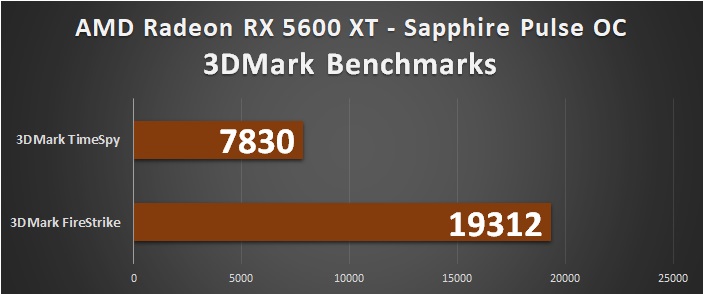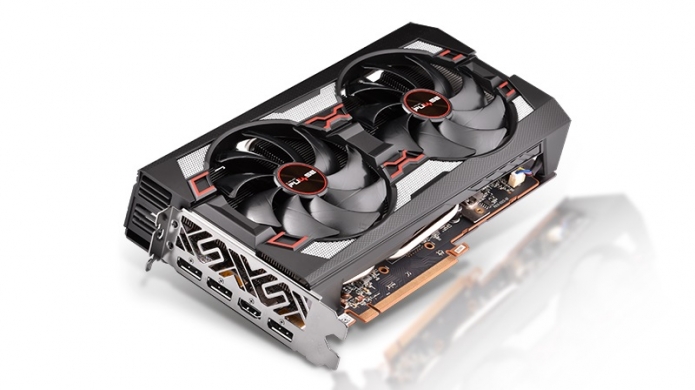Sapphire Pulse RX 5600 XT OC Review
Review By KostaAndreadis @ 02:54pm 07/05/20
Product: AMD Radeon RX 5600 XT - Sapphire Pulse OC
Type: Graphics Card
Price: ~ $549.00
Availability: Now
Link: sapphiretech.com/en/consumer/pulse-radeon-rx-5600-xt-6g-gddr6
The Radeon RX 5600 XT arrives as the latest entry with AMD’s 7nm RDNA Architecture. The same technology that is set to power the next-generation of home consoles from Sony and Microsoft. The 5600 XT represents the affordable but still high-powered entry in the series. A card that takes full advantage of Navi tech but with an eye toward 1080p gamers - in much the same way the 5700 XT set its sights on 1440p displays. And of course, this comes with a more wallet-friendly price point.
The Sapphire Pulse OC edition of the 5600 XT offers up an overclocked Game Clock and Boost Clock of 1615/1750 MHz - putting this version of the card on the higher end of the 5600 XT spectrum. The spot where all the Overclockers reside, where those extra megahertz are used to render a couple of extra frames-per-second. The proposition is simple, a cutting edge 1080p card using AMD’s second generation RDNA architecture. A card for those that not only want to crank-up detail settings to 11, but also take full advantage of a high-refresh rate display. Namely something with AMD’s own FreeSync technology.
Spoiler alert, the results are impressive – with the 5600 XT proving to be a 1080p powerhouse in the performance department. With Sapphire’s card able to look at 1440p and say, “Yeah man, I got you”. But it is not all polygons and rainbows with the Sapphire Pulse RX 5600 XT - there is one significant, and concerning, snap, crackle, and pop. More on that later.
Of Numbers and Heat Sinks
First, the good stuff. Even though the Sapphire Pulse RX 5600 XT idles in the 50-degree Celsius range after extensive testing we were not able to push the load-temperature past 70-75 degrees Celsius – making the Sapphire cooling tech quite good. With two large fans the overall size of the Sapphire Pulse RX 5600 XT is what you would call chunky, a graphics card that enjoys repeat visits to the buffet table – that is, our overstuffed Steam library. Okay, so even though that metaphor kind of got away from us – the same cannot be said for the temperatures. Sapphire’s “Dual-X Cooling Technology” applies the icepack to both the GPU core and the memory.
AMD Radeon RX 5600 XT - Sapphire Pulse OC
- Architecture (GPU): RDNA Architecture (2nd Gen 7nm GPU)
- Stream Processors: 2304
- GPU Boost Rate: 1875 MHz
- Memory Capacity: 6GB
- Memory Speed (GB/sec): 14 Gbps
- TDP: 160W
Where RDNA 2 differs from the current crop of RTX cards from NVIDIA comes with the 7nm chipset and full support for PCI-Express 4.0 – resulting in the fast 6GB of GDDR6 memory in the Sapphire Pulse RX 5600 XT to be exactly that. Fast. Also, RDNA is all about the pipeline, with the goal being more performance per-watt and the graphics card not having to work overtime just to render higher fidelity effects. This then pairs with AMD Radeon Software that offers up technology like Radeon Image Sharpening – which offers up crisper images without impacting performance.
Game Performance
And speaking of performance, let’s get to it. But first, a brief rundown of the hardware setup used in testing the Radeon RX 5600 XT.
- GPU: AMD Radeon RX 5600 XT - Sapphire Pulse OC
- CPU: AMD Ryzen 7 3800X
- Motherboard: MSI MEG X570 UNIFY
- Memory: HyperX FURY DDR4 RGB (32GB at 3600 MHz)
With AMD gearing the Radeon RX 5600 XT towards 1080p gamers, this makes the following 1080p benchmark results important in getting a clear picture of the card’s capabilities.

And the results are, well, impressive. With triple digits possible in many if not all competitive titles. Even the resource intensive Assassin's Creed Odyssey set to Ultra still managed to average 60 frames-per-second. Which in 2020 has become the sort of entry-level number that many look for in the PC space. Ubisoft’s other graphics card devourer, The Division 2 on maximum, managed to stay above 60 in all our tests. And it looked and ran smooth on our AMD FreeSync Premium MSI Optix MAG322CQR display. We tested the recently released Gears Tactics too, where it sat just under 100 frames-per-second on Ultra detail settings.
“No doubt, the 5600 XT lives up to is promise of being an impressive 1080p performer.”
No doubt, the 5600 XT lives up to is promise of being an impressive 1080p performer. But this is where the 1080p target kind-of adds a little wrinkle – with the decision to offer 6GB of memory versus 8GB. An issue that cropped up alongside the launch of NVIDIA’s similarly entry-level RTX 2060 – though the RTX 2060 SUPER bumped it up to 8GB. Why is this a potential problem? Well, that 147.5 frames-per-second DOOM Eternal performance is the game set to Ultra detail settings and not Ultra Nightmare. id Software’s masterclass in tech still looks and runs amazingly well here, but the 6GB memory means not being able to take full advantage of the visual settings.
Pushing the resolution up to 1440p, and we see a performance drop of around 30% on average.

Of course, the story changes, but Star Wars Jedi: Fallen Order still hitting 60 frames-per-second and Forza Horizon 4 still racing in triple-digits means you could easily position the Radeon RX 5600 XT as something for 1440p gamers too. This is great news for those looking to update their display or for those that have recently entered the crisper world of 1440p and are looking for a new card. If tweaking settings and lowering a few things to maintain a broader 60 fps or so across most games is fine with you, the added clock speeds of the Sapphire Pulse RX 5600 XT make it an entry level 1440p card worth looking into.

Something that can also be seen in the 3D Mark results.
Overall
Which brings us to morning cereal – and the surreal - snap, crackle, and pop mentioned in the intro. When 1440p testing began, this happened alongside the connection of our usual external USB-audio card. Something that happens when your gaming rig doubles as a music production workhorse and a general streaming or broadcasting tool. In the age of Zoom and Teams that’s quite a few of us right now. The result; immediate audio stutters across all applications and gaming, with audio editing and production software being completely unusable. Why not switch to on-board audio instead of USB? Well, that’s a question of latency and being able to handle multiple inputs and outputs. For the record, the Sapphire Pulse RX 5600 XT works great with on-board audio.
“The result; immediate audio stutters across all applications and gaming, with audio editing and production software being completely unusable.”
Swapping the GPU with a competitor’s card and the issue went away immediately. Like magic, bringing up the question of why a graphics card would affect audio. Subsequent research found similar issues with owners of Radeon RX 5700 XT cards and other Sapphire Pulse RX 5600 XT owners. This points to an issue with AMD’s own Radeon software or Sapphire’s line of RX cards. It could even be something related to the operating system. In the end it’s not up to us to troubleshoot – even though we spent hours trying to get to the bottom of the problem. Again, when swapping things out for a competitor card the issue disappeared.
So, as great as the 1080p and 1440p performance of the Sapphire Pulse RX 5600 XT is - this is a card that we couldn’t conceive using long term. If you plan on recording audio, connecting microphones or other USB audio devices to your gaming rig - fair warning. If not, the 5600 XT lives up to its 1080p gaming promise. Albeit exclusively.
|
What we liked
Impressive 1080p performance
Great for 1440p gaming too
Increased clock speed with respectable cooling
AMD's 7nm RDNA 2 Architecture
No hardware ray-tracing
|
What we didn't like
Only 6GB of video memory
Doesn't play nice with USB-audio devices
AMD Radeon Software and drivers still lag behind the competition
|
We gave it:
6.5
OUT OF 10
|






















